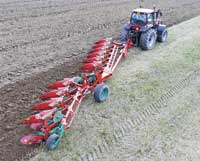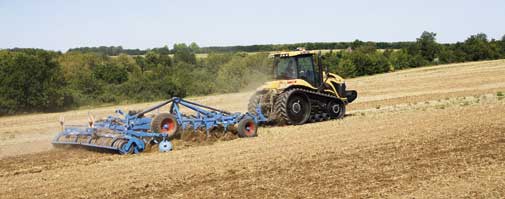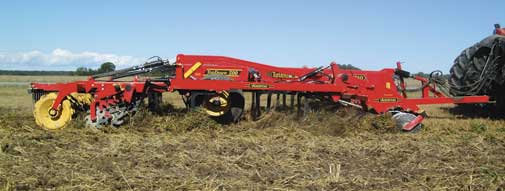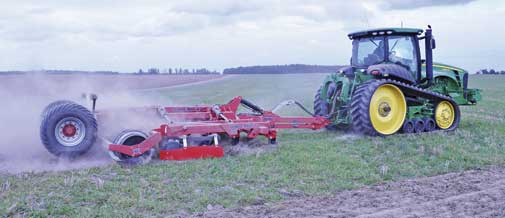What are the likely trends in cultivation? Five makers comment

Tillage trends never seem to stay the same for very long. The drive to cut fuel and labour costs has seen ploughing and power harrowing cede ground to faster disc-and-tine systems. But rotational ploughing is now becoming more popular.
So how do the equipment manufacturers see things going over the next few years?
LEMKEN
Lemken’s Mark Ormond believes the biggest driver in cultivation design and operation is now grassweed control – blackgrass and sterile brome.
He says Lemken is doing trials to see whether an initial shallow cultivation is more successful in encouraging a greater number of germinating weeds and volunteers than a deeper pass.
“It may be that a pass with a cultivator at just a few inches is the correct route to take,” he says. “What is clear, though, is that it is now essential to achieve a good kill of weeds in the post-harvest period.”

In terms of trends, Mr Ormond points out that tine-only cultivators are becoming increasingly popular – they are cheaper than tine/disc combinations and easier to maintain. By changing the width of their wings, they can be made to work effectively at both shallow and at pan-busting levels.
For ploughs, he says the trend has been for the purchase of larger ploughs to suit available horsepower and adds that the return to the plough has been quite noticeable.
“Many growers are now having to rotationally plough at least a third of their land each year to try and contain grassweed problems,” he says.
VADERSTAD
Michael Alsop, who heads up Vaderstad UK, reports that sales of his company’s range of surface cultivators is now at “sensible” levels following a surge of activity during the 2008/2009 season.
“Although less than last year, the demand for our cultivators remains buoyant,” he says. “And the recent improvement in wheat prices has prompted quite a number of last-minute orders.”
Pleasing as this is, he reminds growers they should always keep their options open when deciding on cultivation techniques.
“No two seasons are ever the same and it looks as if we can expect more extremes of weather in years to come,” he says. “There are those times when it can be simply too wet to surface cultivate and ploughing is the only sensible route to take and there are also seasons when surface cultivation is the obvious system to use.”

Mr Alsop believes there is now a greater understanding by growers of what they are trying to achieve with their cultivators in terms of soil loosening and moisture control.
“The design of cultivators is now much more advanced than it used to be and, in the main, they perform a better job,” he says. “Our view is that there is now financial justification in investing in new cultivators which offer higher outputs and a better quality of work.”
In terms of trends, he says that growers are now ordering wider working cultivators – the result of more powerful tractors, larger farms and reduced labour, he says.
“We have sold a number of 8m drills this year and, where we were selling 3m or 4m versions of our TopDown one-pass disc, tine and press cultivator, it is now more normally 5m or 6m models.”
KVERNELAND
Kverneland’s Graham Owen makes the point that with fewer and less effective chemicals available to control blackgrass, growers with such problems have little choice but to try rotational ploughing – ploughing a percentage of the farm each year.
He says that plough sales of all makes peaked three years ago with about 1100 units but have now declined slightly to about 900 units – which is still a lot of ploughs.
“This would indicate a significant number of growers is now using the plough for at least part of their crop establishment needs,” he says.
He adds, though, there will continue to be a big market for surface cultivators. Farming practices have now evolved to the point that, with the emphasis on autumn-sown crops, ploughing more than a percentage each year is not a real option for most.
Just moving the top few inches of ground, however, can lead to soil compaction problems and modern one-pass cultivators now have deeper tines which can be set to loosen soil to a depth of up to 30cm or more – Kverneland’s CTC cultivator, for example.
“It is a development now adopted by several manufacturers and one brought about by there being more powerful tractors,” says Mr Owen.
SUMO
Extra tractor power has, in many ways, also been the catalyst for the popularity of Sumo’s Trio primary cultivator, sales of which are reported by the company’s Peter Homer to be continuing to develop.
“I think growers are now increasingly aware of ensuring soil is loosened at plough-pan level to help drainage and root development,” he comments. “The Trio has a bank of tines which can operate at up to 40cm and, in dry ground conditions, can create useful fissures in the soil structure.”
These tines are followed by a double row of discs and then by a press – one with notched rings to ensure they keep turning when conditions are not as good as they might be. Trailed versions of the Trio can also be fitted with a front set of discs.

“I believe the Trio is a genuine one-pass cultivation system,” he insists. “It should be a good antidote for growers who suffer from recreational cultivation – an inability to refrain from giving a field another workover when it’s not needed.”
One of the most interesting developments of late, though, is the use of cultivators to sow oilseed rape and, by all accounts, it is a system which is working very well. The reasoning is that soil loosening tines create ample room for root development and there is good soil/seed contact in warm, moist soil which results in even germination.
The seeder unit is simply bolted on to the cultivator and the seed, metered by a land wheel, is broadcast on to the ground and pressed.
SIMBA
According to Simba International’s managing director Guy Leversha, oilseed rape sown using this system last year has produced above average yields.
“It does appear to be an effective way of planting oilseed rape – particularly at a busy time of the year when a one-man, one-pass operation clearly has its advantages,” he says.
Mr Leversha also cites this development as one of the reasons why sales of his company’s presses have increased this year – maintaining soil moisture levels and pressing after sowing is clearly recognised as a key operation.
“Moisture retention is also important for those who choose to plough,” he says. “Inverting soil and then moving it about is a sure way of losing soil moisture.”
In terms of stubble cultivation, Simba’s SL range probably epitomises the company’s current take on the cultivation scene. It is a cultivator which is quite different from the heavy disc and cultivation “trains” used a few years ago.
The SL employs a combination of discs, loosening tines, and press. There are two configurations: Discs followed by tines, discs and press; or two rows of discs followed by tines and press.
The latter arrangement is designed to provide a better chop of crop residues and help avoid any build-up of trash around the tines.
“The trend in recent years has been to use these cultivators with the discs set at relatively shallow depths and the tines loosening the soil some inches below,” he explains. “I think that in this year’s dry conditions, the tines could be set to work rather deeper – up to 35cm – and provide a good soil shatter without bringing raw soil to the surface.”
For the future, Mr Leversha believes the industry will see a continued decline in the use of heavy disc harrows which relied on their weight to penetrate stubbles. A combination of tines and smaller discs clearly has much the same effect and probably creates less damage in terms of compaction.
When it comes to the now much advocated controlled traffic systems, he says he has his reservations.
“It’s a sound idea with good intentions but I’m not sure it can actually be achieved – the practicalities of it all seem too difficult,” he says.
AMAZONE
How wide does a machine need to be or how many machines are required to complete the workload on time? How many hectares can a machine do an hour, how many a day? Amazone has a useful performance calculator on its website www.amazone.de/1513.asp.
Click on Online-version at the bottom of the page, then the Union flag.
The tool covers crop protection, fertiliser application, tillage, drilling and precision seeding into which different machinery options can be entered.
Acreage, working days, working width, working speed and farm-to-field distance are all entered. The calculator then works out whether the suggested level of mechanisation is sufficient but also gives the total working hour requirement, hourly outputs and individual operation times.

